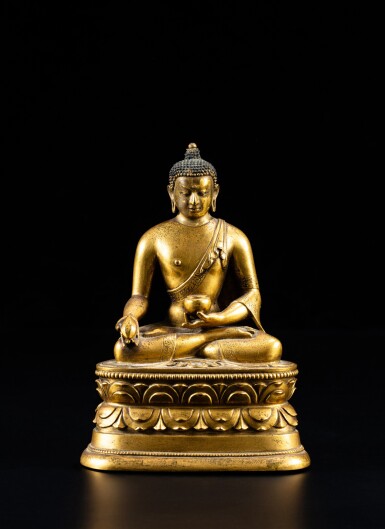Himalayas: The Richard R. & Magdalena Ernst Collection of Important Tibetan Paintings and other Himalayan Works of Art
Himalayas: The Richard R. & Magdalena Ernst Collection of Important Tibetan Paintings and other Himalayan Works of Art

Property from a French Private Collection | 法國私人收藏
A rare Zanabazar school gilt-bronze figure of Bhaisajyaguru Buddha, Mongolia, 18th century | 蒙古 十八世紀 扎那巴扎爾風格 鎏金銅藥師佛坐像
Lot Closed
December 15, 11:35 AM GMT
Estimate
30,000 - 40,000 EUR
Lot Details
Description
Property from a French Private Collection
A rare Zanabazar school gilt-bronze figure of Bhaisajyaguru Buddha,
Mongolia, 18th century
holding a myrobalan fruit in his right hand and begging bowl in his left, wearing a diaphanous monk’s robe with finely incised hems, seated in vajraparyankasana on a tall, stepped lotus pedestal with alternating upper and lower petals
H. 15 cm, 5 7/8 in.
__________________________________________________________________________
Collection particulière française
Rare statuette de Bouddha Bhaisajyaguru en bronze doré de l'école Zanabazar, Mongolie, XVIIIe siècle
__________________________________________________________________________
法國私人收藏
蒙古 十八世紀 扎那巴扎爾風格 鎏金銅藥師佛坐像
Collection Jacques Fesquet (1921-2004), French Ambassador to Mongolia (1978-1982), and thence by family descent.
__________________________________________________________________________
前法國駐蒙古大使(1978-1982)Jacques Fesquet先生 (1921-2004)收藏,此後家族傳承
This fine gilt bronze depicting the Medicine Buddha is a true example of the school of Zanabazar dating to at least the first half of the eighteenth century, following the stylistic and iconometric conventions laid down by the great master Zanabazar (1635-1723) in the later years of the seventeenth century, cf. a closely related gilt bronze Bhaishajyaguru in the Choijin Lama Temple Museum, Ulaanbaatar, dated to the seventeenth century, with similar proportions and otherworldly gaze, almost identical incised robe pattern and lotus petal design of the pedestal, and shape of the fruit in his right hand, see N. Tsultem, Mongolian Sculpture, Ulan-Bator, 1989, pl. 90. Zanabazar, one of the most important Buddhist sculptors of the Qing dynasty, was inspired by early art from India and Nepal that was revered throughout the Himalayas as treasure from the motherland of Buddhism. The influence is manifest in the sensuous modelling of the human form in the Nepalese manner, and the characteristic tiered pedestal of eastern Indian Pala period (8th-12th c) ateliers.
__________________________________________________________________________
本尊鎏金銅藥師佛為扎那巴扎爾風格經典之作,年代至少可追溯至十八世紀前半期,其風格及圖像遵循十七世紀晚期札那巴扎爾大師(1635-1723)所制定的工藝傳統,參見烏蘭巴托興仁寺博物館中一尊相似鎏金藥師佛,其斷代為十七世紀。兩尊佛像比例相仿、神韻相似,其袈裟上所刻飾紋樣、蓮花瓣底座設計,以及右手所持寶果近似相同,見N. Tsultem,《蒙古雕塑》,烏蘭巴托,1989年,圖版90。扎那巴扎為清代最重要的佛教雕塑家之一,其靈感來源於印度和尼泊爾早期藝術,兩者在喜馬拉雅山區備尊崇,並被視為佛教珍貴寶藏。本尊佛像展現尼泊爾式感性的人體造型以及東印度帕拉時期(公元八至十二世紀)風格的底座,正為受其影響之最佳見證。
